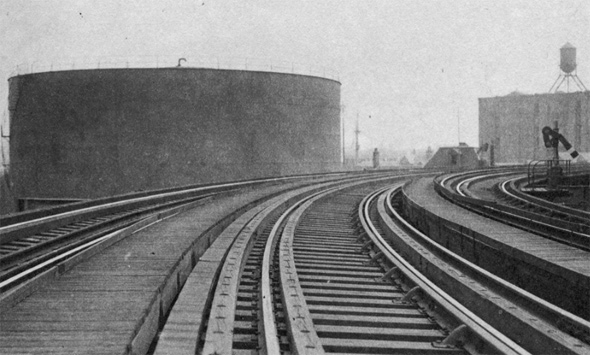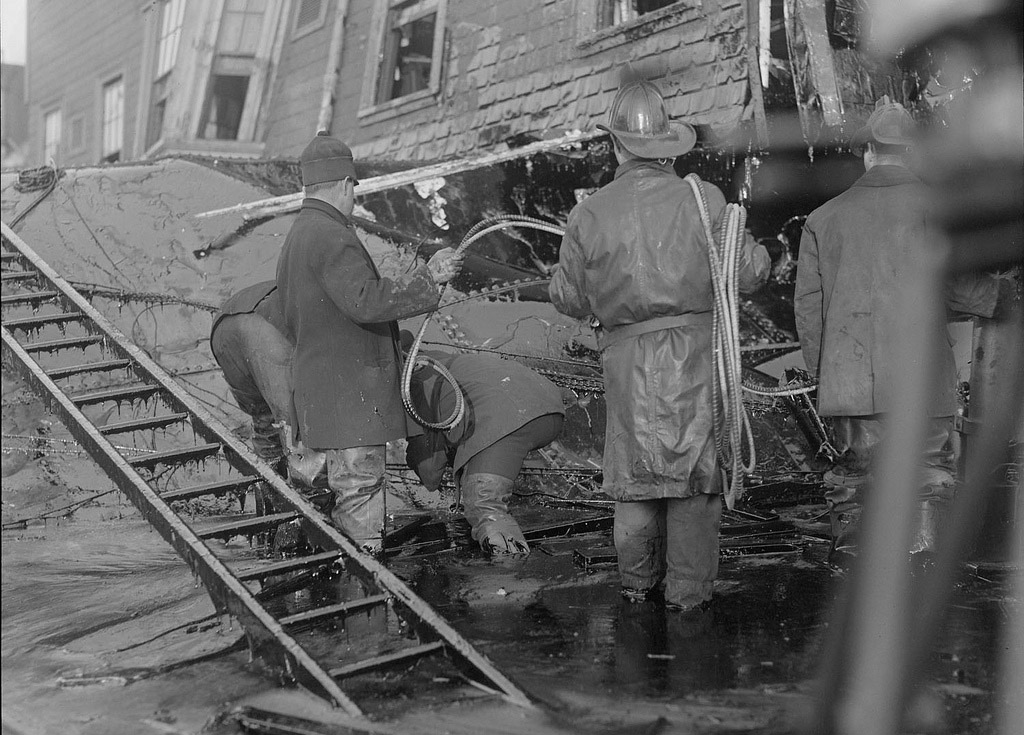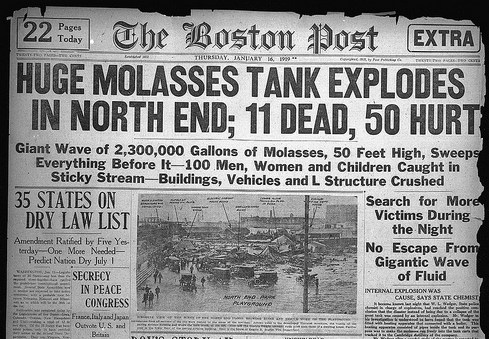Today is, of course, the anniversary of the Great Molasses Flood, when a poorly maintained tank of molasses on the North End waterfront exploded at 12:40 p.m. on an unseasonably warm January day, sending a viscous brown tsunami down Commercial Street, killing 21 people and several horses, destroying buildings and bending the elevated. Read more.
Molasses
Bostonians this morning lined the perimeter of the Purity Distilling Co.'s leaky, 50-foot-tall molasses tank, which burst around 12:40 p.m. on Jan. 15, 1919, creating a gooey flood that killed 21 Bostonians and a number of horses and destroyed buildings in its path. Read more.
Pre-explosion view of tank from Commercial Street el, from Boston City Archives.
The Boston Archaeology Program, Parks Department and Landmarks Commission will commemorate the 21 people who died in a flood of molasses on Jan. 15, 1919, in a ceremony that starts at 10:30 a.m. on Tuesday at Langone Park in the North End - near where a tank of hot molasses burst, sending a flood of girder-bending goo down Commercial Street.
No, not the sweet smell that would rise every summer from the North End. Pacific Standard explains how the disaster on Jan. 15, 1919 led to dramatic changes in the way cities and states regulate construction projects to reduce the odds of shoddy work leading to catastrophe (we saw a similar thing after the Cocoanut Grove with fire-safety regulations).
Flood aftermath. See it larger. From the Library of Congress collection.
Stephen Puleo, who literally wrote the book about the 1919 Great Molasses Flood (Dark Tide), will give a talk on the deadly, brown, gooey tsunami at the BPL on Jan. 15 - 100 years to the day after a shoddy, 50-foot-tall molasses tank on Commercial Street in the North End exploded, sending a deep river of warm molasses along the waterfront at 35 m.p.h., killing 21 people and several horses, demolishing a fire house and warping the elevated tracks that then ran above the street. Read more.
BroadwayWorld.com reports on the planned May opening of an off-Broadway production of "Molasses in January:"
An original new musical about a struggling family of Italian immigrants who are literally swept up in the Boston Molasses disaster of 1919.
Too soon?
Associated Press reports Harvard scientists who study fluid dynamics turned their eye to the Great Molasses Flood and, after studying how molasses flows at different temperatures, concluded that the relatively warm molasses that flowed out of that North End tank quickly cooled in the relatively chill Boston air (the disaster happened during one of our January thaws), going from liquidy to gooey and trapping people and horses.
Earlier:
Also: Molasses is a non-Newtonian fluid.
Up to their knees in molasses, looking for victims.
Among other things, the Great Molasses Flood took out the elevated subway tracks that ran over Commercial Street, as shown in this photo by news photographer Leslie Jones.
At 12:30 p.m., take a moment to remember the 21 people killed by a gooey, bittersweet flood of more than 2 million gallons of molasses, just moments after the machine-gun-like sound of rivets giving way echoed across the North End and the tank burst on an unseasonably warm January day in 1919, thanks to shoddy construction by the tank's owner. Read more.
Around 12:30 p.m. on Jan. 15, 1919, a large, poorly maintained tank full of molasses on a warm day burst, sending a huge wave of gooey death rampaging down Commercial Street, drowning or crushing 21 people and several horses and cats as it battered the supports of the el that ran down the street and knocked a neighboring fire station off its foundation.
As with so many other major events in the early and mid-20th century, Leslie Jones was there to chronicle the aftermath.
And what better place for it than the Greenway? Not because the 1919 sticky death flood happened there, but because the Greenway is where all memorials are supposed to go these days (and the state is seeking proposals for what to put atop Big Dig ramps).
Scientific American breaks it down for us, explains why the nature of molasses made the flood far worse than if it had just been some rogue wave tearing through the inner harbor:
Just out: "The Great Boston Molasses Flood" by the Dead Milkmen:
Sweet holy Jesus, there's a wall of molasses coming for me and my fam-i-lee.
Listen to the lyrics at the beginning, and you'll notice that whoever wrote them obviously read their Puleo.
H/t Liam Sullivan.
On an unseasonably warm January 15, 1919, a 50-foot-high storage tank of molasses - meant to be turned into rum in the rush before Prohibition - burst on Commercial Street in the North End, creating a giant wave of sticky brown death that destroyed buildings, bent the el and killed 21 people.
On this day in 1919, 21 people died when a poorly maintained molasses tank off Commercial Street exploded, sending more than 2 million gallons of the syrup roaring down the street at 35 m.p.h. The above photo is from the Boston Public Library's collection of molasses images and shows what the stuff did to the elevated that ran down the street at the time.
- More from Wikipedia
- Dark Tide - The definitive book on the disaster.
Steven Puleo, who wrote the book on the Great Molasses Flood, which happened 90 years ago today, explains what it's like to write a book about something like that:
At first, the woman in front of me jumped a bit when I popped my head over the seatback and said, "Would you like me to autograph that?"
We had just taken off from Charlotte, on a connector flight from Boston to Hilton Head, and her movement had caught my eye when she pulled a copy of Dark Tide from her bag and settled in to read. When I asked the question, she glanced quickly from me to the book and back to me again, and said, "No – you're not…are you?" But there's no author's photo on the paperback, after all, so she wasn't entirely sure. ...
Michael reminds us that tomorrow is the 86th anniversary of the Great Molasses Flood, when 21 people drowned in molasses after a giant North End storage tank full of the stuff burst. Molasses fans will recall it happened on an unseasonably warm January day - good thing there aren't any molasses tanks left in the North End today, eh?








